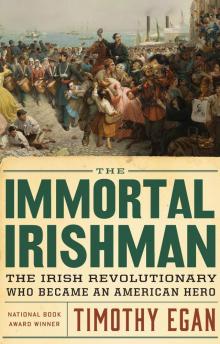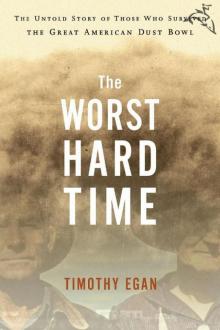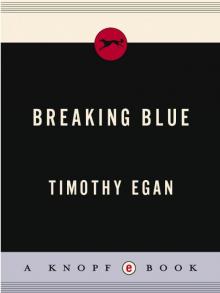- Home
- Timothy Egan
A Pilgrimage to Eternity Page 5
A Pilgrimage to Eternity Read online
Page 5
Or I can divert by train twenty-three miles inland to Saint-Omer, one of the overlooked marvels of medieval Europe. Saint-Omer is near a monastery where I want to stay, just off the Via. I’m told there’s a library holding books that are thirteen hundred years old.
Full disclosure: I’m not impressed by Sigeric the Serious. Aside from the fact that he was mirthless by reputation, his record of the Via is minimalist and unmemorable. It’s basically a listing of all his stops, without comment. But as the first person to write up a specific pilgrim route connecting Canterbury to Rome, he gained geographic immortality. It’s as if we knew about the Lewis and Clark trail from the notes of the company clerk. As an asterisk in history, Sigeric is also remembered for giving lousy advice to King Ethelred the Unready, who took the throne in 978 after plotting the murder of his half brother Edward the Martyr. (Like some Native American names, these old English monikers will often tell you everything you need to know about a person.) Sigeric, as archbishop of Canterbury, urged the king to pay off the Vikings to keep them from sacking Kent. The Norsemen took the protection money, ten thousand pounds of silver, but invaded anyway a few years later. Saint-Omer it is, then, off to see some of the oldest books in the world.
On my way to the station, I step away from a swoosh of police cars, racing somewhere in a heaving wail of Euro sirens. The somewhere is not far, just a few blocks from the church. The commotion is outside the office of Secours Catholique, which distributes food and clothes to refugees—all without proselytizing, mind you. Earlier this spring, police fired tear gas at volunteers who were attempting to give breakfast to thirty people. Countless children have been abandoned and are hungry, the charity pleaded. Didn’t Christ say we have an obligation to help “the least of these brothers of mine”? Sorry: it would only encourage them to stay, the authorities say. So, French police are trying a modern variant on the Calais siege: starve the migrants into leaving.
The fight today is over showers. Secours Catholique brought in two portable trailers with water tanks—a chance for some of the wanderers to clean up. This infuriated the mayor, who had a dumpster dropped at the entrance to prevent access. Somebody has called in a shower violation this afternoon, bringing the enforcers. A priest vows that he won’t surrender until a few hungry children have been taken care of.
So here is another boomerang: a religion whose leaders once called on followers to wage savage war against faraway cities held by people of a different religion now fights to feed and protect forsaken members of that same faith from those same faraway cities. It’s heartening, a selfless act. The handful of people who still work every day to keep Christian tradition alive in France—those who should be most threatened by loss of identity from outsiders of another religion—are practicing the core tenets of what they preach. On this day in May, the great centuries-old sanctuary of Notre-Dame may be unwelcoming and lifeless, but don’t let it be said that the Catholic Church has given up on Calais.
FIVE
THE LOST CITY OF SAINT-OMER
One way to God in the Middle Ages was to write from first light till dusk in a scriptorium stuffed with silent monks. Your fingers ached and seized up. Your lower back was a nag of pain. Your eyes blurred. Your legs went numb. Your stomach growled. Your mind wandered, making you miss a word, which could lead to a misinterpretation by a high-ranking reader, who then committed heresy by repeating the error, ending with his head on a spike. Your home and place of work was a factory of recluses who were not allowed to talk while they put goose quills to parchment, copying sacred text. In this way, for more than a thousand years, books were produced and the spiritual and intellectual life of the Western world was preserved and passed on. These monks were machines in service to advancing Christianity and culture. It could take four men working two years to create a single large and lavishly colored manuscript. Some of the scribes couldn’t read. Others were nearly blind.
The tattoos of knowledge were pressed between the skins of animals. I’m holding one now, dating to the twelfth century, with a cover of cattle hide so thick I can run my hand over the bristled hairs. Inside, the colors pop—brilliant reds, blues, and greens, applied to the parchment with egg white. Turning the stiff pages with my white-gloved hands, I notice little notes on the side. The imposition of silence didn’t keep the word slaves from making personal remarks in the margins:
“I am very cold.”
“Thank God, it will soon be dark.”
“Writing is drudgery.”
“The parchment is hairy.”
“I am exhausted.”
It sounds dreadful, this life. But the daily grind of writing was also a form of prayer, and so, another passage to eternity. “Monasteries had power, they produced these books for people in power,” says Rémy Cordonnier, the head of ancient collections at the library of Saint-Omer. “The writing was also a way to know yourself, a way to communicate with God, and a way to get into heaven.” Cordonnier is blue-eyed and bearded, sockless today with a dress shirt and jeans. He has a doctorate in art history, which served him well when he made one of the most extraordinary discoveries in the book world: a First Folio of the collected works of William Shakespeare, hiding in musty anonymity just a few feet from Latin treatises on indecipherable topics. He has opened the inner sanctum of the library to me, on very short notice, because he loves what these books mean, and he seldom passes up a chance to let the long-dead voices in the volumes speak again.
I found this great vault of literary treasures on an unremarkable side street, next to a school. Saint-Omer was once a magical and lively place, a scholastic center, a trade exchange for wool, wine, and wisdom. A Burgundy-born bishop, Omer, working the low country of a pagan corner of Europe, sent monks forth to found a monastery on the banks of the River Aa in the year 638. It was a buggy marsh with a couple of hillocks, sparsely populated by people living hard, stunted lives—a tribe of Germanic Franks. A town sprang up around the abbey. The brothers diverted the river for agriculture, a web of water still put to use by a handful of farmers today. The social order—laws and rules to live by, a community of commerce, a shared sense of purpose—had largely collapsed with the fall of the Western Roman Empire more than a century earlier. To these barbarians, as they were long called, Christians brought illuminated books, advanced carpentry, refinements in how to grind grain using the power of water through a mill. The church “stood for everything that was progressive, enlightened and humane in Europe,” wrote Johnson in his history of a faith.
Christians came not to conquer. What animated them was the story they told, the same one passed on by the Celtic monastics from Ireland: a son of God who was also a man, a Jew born in Galilee who lived a short life preaching around Judea, was killed in Jerusalem by a Roman prefect, and then defied death itself. Many dozens of people saw the risen Christ; some chose death rather than recant. This Son of God spoke in the idiom of the people, using parables to make his points. If his message was easy to understand, it was even easier to embrace. Love is intoxicating. Hate is poison. Above all, take care of the least among you. Revere creation. He preached tolerance rather than condemnation, and liberation from rigid societal norms of class and religion. He was a charismatic rebel—defiant in the prime of his life, passive at his execution. He was called Christ from the Greek word Kristos, anointed one.
Over the centuries, the abbey grew upward and outward, with cathedral-high arches and fine-chiseled stone throughout. And it grew inward, as generations of tonsured monks labored over hundreds of manuscripts. It is said that Irish ascetics saved civilization, harboring the Western world’s written knowledge while Europe fell under plunder to illiterate hordes. But more broadly, in the early Middle Ages, Christian ascetics created a civilization that grew into the Europe that would determine much of the world’s fate. With books tied to their waists, the wandering evangelists founded nearly 150 monasteries between 575 and 725. By 1300, Saint-Omer was one of the biggest
cities on the northern mainland. The pattern that took hold here was matched elsewhere: from monastery in a marsh or forest, to town, to thriving regional community, to literacy and laws, to institutions of learning and prayer, to a semblance of modern life. It certainly wasn’t democratic. And women had very little standing. But what is still called the Dark Ages was anything but.
Now Saint-Omer is a shell of forgotten Christianity, fossilizing by the day. I feel some sadness for this place because it is so intriguing yet doesn’t quite know what to do with its endowment from the ages. That’s my initial impression. Its standing monuments are impossibly oversized for a town of 14,000. I turn one corner and come upon the vast remains of the Abbey of Saint Bertin, an open-air ruin of the original Christian footprint. It was rhapsodized by Victor Hugo for its ghostly grandeur. The floor is grass. The roof is sky. The arched Gothic entrances are intact, in places, with headless saints of stone mounted on pedestals. “Such places are truly holy,” Hugo wrote, “man has meditated and communed with himself therein.” I cross over a canal, walk down a row of immaculate seventeenth-century town houses, and stumble upon a stoop from which Thomas Becket preached during his exile here, while in his less deadly first feud with Henry II. I leave a sleepy square after a life-affirming breakfast of café au lait and almond-crusted pain au chocolat to find the Bibliothèque de Saint-Omer.
From the street, the building is a blank wall of don’t-look-twice, about as nondescript as a medieval department of motor vehicles. After the doors open, I walk up one flight of steps and enter a wood-paneled salon of thirty-five thousand rare books. So many stories. So many opinions. So many prayers. And most of them incomprehensible to the average reader. As my blue-collar dad used to ask, in appreciative and near-drunken wonder while listening to blind Italian tenor Andrea Bocelli, “What’s he trying to say?” Almost a third of the volumes were rescued from the destroyed Abbey of Saint Bertin. Others were saved from Henry VIII’s rampage against the monasteries in England and smuggled across the Channel. The spines were built to last, with bulging leather vertebrae. Consider that the Book of Kells, the illuminated manuscript of the four Gospels, is Ireland’s greatest national treasure, finished about the year 800. People line up in the rain of Dublin to view the monks’ calligraphy on display inside Trinity College. But Saint-Omer’s library has hundreds of minor masterpieces from the same period onward. None are as impressive as the Book of Kells, but each in its way is a work of art—just as ancient, just as intricate, just as compelling.
A single book in this room is worth more than the real estate on the block: a Gutenberg Bible. It’s one of only four in France, and one of fewer than two dozen or so intact originals left on the planet. Writing was slow to evolve. The earliest expressive forms were scrawls on flat clay tablets—cuneiforms. What they wrote about was utilitarian. This changed with the Greeks. Among other things, they had a sense of humor, evident in lighthearted poetry on wine jugs. The Romans wrote on scrolls of dried papyrus; smaller ones, tucked in the pockets of centurions, were portable, like paperbacks. History, philosophy, epic poems—all found their way into the transcribed concerns of the scrolls spread by the Empire. Then, for a thousand years, from the fall of Rome in the fifth century to the dawn of the printing press with Gutenberg’s Bible, books were made by unknown toilers in places like Saint-Omer.
But there was a limit to how much knowledge one person could acquire. Medieval scholars believed that each human could store only a finite amount of information. God set the range. And how did people know when they’d reached the point where not another nugget of new thought could be taken in? We can only wonder, for the scribes did not leave behind a tool for measuring full mental capacity.
I ask Cordonnier whether I can see the oldest surviving printed book in the world, his Gutenberg. It would be a disservice to my calling if I didn’t try. Cordonnier laughs at my request; he wonders if I’m being ironic. Ce n’est pas possible, says the librarian. The Gutenberg is far too valuable, worth a hundred million dollars or more. Under lock and key and heavy guard. As a consolation, Cordonnier guides me to the Shakespeare. It is visible through a thick glass case, opened to The Tragedie of Romeo and Juliet. Published in 1623, seven years after his death, the First Folio contains the bulk of Shakespeare’s output. It is luminous. Not a flat or dead thing. It was Cordonnier who made the discovery in 2014. He was sifting through the collection of English-language literature when a very thick and heavy book caught his eye. The title page was torn off. But once Cordonnier more closely examined it, he realized that he had come upon the find of a lifetime. For a lover of ancient texts, it was an emotional moment.
The digital age has done nothing to dim the popularity of Shakespeare. But what about the Bard’s book-mates stacked on shelves of antique wood here in Saint-Omer? Who still listens to voices from the European literary cradle, slowly fading away in this nursing home of geriatric books? Who reads Latin calligraphy, or Old English? Who has any sense of what these books are trying to say? At one time, nearly every word in this library was dictated truth, passed on in the copying of scribes. Gutenberg’s printing press made a mockery of that monopoly. Anyone’s word could be dictated truth, and so it was, with new versions of the Bible customized for various sects. In our time, the chaos of the internet reduced truth to a near-worthless commodity. But surely all that medieval meditation on God has some place in an era of disposable thought.
“I can see a day when people won’t have any idea what the religion in these books means,” says Cordonnier. “It is already happening. The students next door, they don’t know what this is. They feel they don’t have to know. But look around France. Our holidays are still tied to religion. The names of our cities, our streets, come from religion.”
Cordonnier was raised Catholic, but now—he’s a weddings and funerals kind of churchgoer. In that, he is typical of the French. Although 53 percent consider themselves Catholic, only 5 percent of the faithful attend Mass on a regular basis—which means that practicing Catholics make up less than 3 percent of the population of France. “I’m not very religious,” says Cordonnier, “but I think religion has been good overall. A civilizing force. Now, we can do good without religion, so people don’t feel they need it anymore.” And how about himself? The man who spends his days among the words of those who saw penmanship as prayer—does he still need it? “I will tell you this,” he says, after giving my question some thought. “Devotion is one of the only things that you don’t see in other species.”
* * *
—
A FEW BLOCKS from the library, construction crews are working to spiff up Saint-Omer’s cathedral, Our Lady of Miracles. It got its start not long after the abbey rose on the riverbank in the seventh century. I duck into the church in search of its Rubens painting, Descent from the Cross. There’s also an astronomical clock and an enormous Gothic organ. All are spectacular. But none are as intriguing as a rough stone tomb off to one side, dating to 723. This scratched-up rock bed holds the remains of Erkembode—the Saint Who Walks. The legend of Erkembode is that he was a selfless man who traveled throughout Flanders on foot looking for land that nobles might give to the poor. His legs eventually gave out, leaving him crippled. Atop the tomb today are dozens of tiny shoes. They are pink and green, spotted and flowered, plastic and leather, Velcro and laced. None would fit the feet of anyone older than five. Children who cannot walk make a pilgrimage to Saint-Omer to leave their shoes atop the tomb of the Saint Who Walks, in hopes of—well, something.
The shoes of little disabled children are overpowering, and almost move me to tears. Christopher Hitchens would be scornful. Miracles were cheap magicians’ ploys used early on to get people to believe in Christianity—“the tawdriness of the miraculous,” he called it. That age is long gone. Now, what passes for supernatural events are hallucinations—of statues weeping and bleeding—and unworthy of a god with power, he wrote. I take his first point, for miracles were indeed a re
cruiting tool, wielded first by Jesus, who famously changed water into wine to keep a wedding party going at Cana. (Note to Mormons.) But it’s hard to look at this thirteen-hundred-year-old tomb and be entirely dismissive. Every few days or so, the shoes are cleared away. And every few days after that, the tomb is covered again. The church does not promote it. It happens on its own. Do children walk because of it? Probably not. But Erkembode’s tomb tells them they are not alone; they can join a community of hope.
Nearby, a hive of construction blocks the main entrance to the Jesuit chapel of the old college, which shoulders the great library where I spent most of the day. When Catholics in England were banned from educating children in their faith, the Jesuits built an expansive college here in 1593. The school was filled with young English elites and produced a signer of the American Declaration of Independence and a coauthor of the Constitution—members of the Carroll family. Another graduate, after the college was forced to move, was Thomas Francis Meagher, the Irish revolutionary, American Civil War general, and governor of Montana Territory. Then it was largely abandoned and fell into disrepair. Now, masons, cement mixers, and stone polishers labor on different parts of the five-story façade and marble-floored interior. The massive old Catholic school is undergoing a top-to-bottom restoration, “where heritage plays a major role,” as a sign explains.
So, my first impression of Saint-Omer was wrong. The town on the banks of the River Aa has figured out what to do with its endowment from the ages. The great books, the college where generations of Catholics were educated, the eighth-century tomb, and the tiny shoes in the cathedral. Saint-Omer realizes that it cannot escape its past. The Lost City has embraced all that nearly fell away. The ossified shell of ancient Christianity will be polished, highlighted, sold to tourists, though its overall meaning may be more elusive with each passing day.

 The Immortal Irishman
The Immortal Irishman The Worst Hard Time: The Untold Story of Those Who Survived the Great American Dust Bowl
The Worst Hard Time: The Untold Story of Those Who Survived the Great American Dust Bowl The Good Rain: Across Time & Terrain in the Pacific Northwest
The Good Rain: Across Time & Terrain in the Pacific Northwest Breaking Blue
Breaking Blue Lasso the Wind: Away to the New West
Lasso the Wind: Away to the New West The Big Burn: Teddy Roosevelt and the Fire That Saved America
The Big Burn: Teddy Roosevelt and the Fire That Saved America Short Nights of the Shadow Catcher
Short Nights of the Shadow Catcher A Pilgrimage to Eternity
A Pilgrimage to Eternity The Worst Hard Time
The Worst Hard Time The Big Burn
The Big Burn